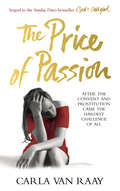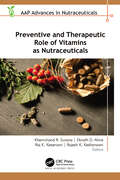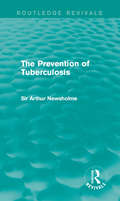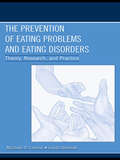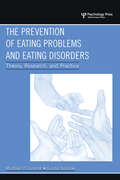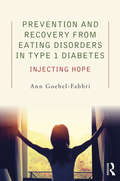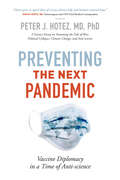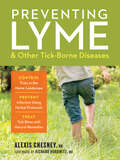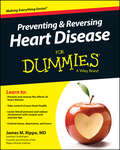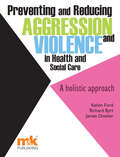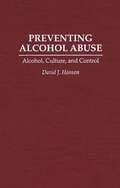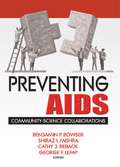- Table View
- List View
The Price of Passion: A Memoir
by Carla Van RaayThe Price of Passion is the eagerly awaited sequel to Carla van Raay's international bestselling memoir, God's Callgirl.A former nun and prostitute, Carla van Raay thought she had come to terms with her traumatic past. But then she received a phone call that threatened to upset the balance once again. Carla had first met Aaron at a tumultuous time in her life. She had left a convent after 13 years of bitter cruelty, lost her virginity in a brutal fashion to a man she barely knew, and then hastily got married before giving birth to a beautiful daughter. Now Aaron was back. And what's more he wanted to resume a relationship that had been intense, yet short-lived. But so much had happened since then. Carla had left her husband and, after years of repression in the convent, had turned to prostitution.The Price of Passion is a very personal story written with honesty and raw emotion. It is the story of two people who have tried to overcome abusive pasts embarking on a new, yet equally challenging, journey; but neither could have foreseen what lay ahead.
Preventive and Therapeutic Role of Vitamins as Nutraceuticals (AAP Advances in Nutraceuticals)
by Khemchand R. Surana Eknath D. Ahire Raj K. Keservani Rajesh K. KesharwaniThis new book provides informative coverage of recent breakthroughs in vitamins and their ability to prevent disease, manage health issues, and treat chronic illness. It describes the beneficial effects of vitamins as nutraceuticals in treating cancer, for improving the immunity of patients with HIV and AIDS, for the treatment of tuberculosis, and for the management of infectious diseases, such as viral infections, microbial infections, and COVID-19. The functional activity of vitamins in brain health and obesity management is also explored for the management, prevention, and delay of hypertension and related problems. The volume also covers vitamins that play a role in neurodegenerative diseases as well as those that can be used for weight loss and obesity, blindness and vision issues, baldness, and skincare issues.
Preventive and Therapeutic Role of Vitamins as Nutraceuticals (AAP Advances in Nutraceuticals)
This new book provides informative coverage of recent breakthroughs in vitamins and their ability to prevent disease, manage health issues, and treat chronic illness. It describes the beneficial effects of vitamins as nutraceuticals in treating cancer, for improving the immunity of patients with HIV and AIDS, for the treatment of tuberculosis, and for the management of infectious diseases, such as viral infections, microbial infections, and COVID-19. The functional activity of vitamins in brain health and obesity management is also explored for the management, prevention, and delay of hypertension and related problems. The volume also covers vitamins that play a role in neurodegenerative diseases as well as those that can be used for weight loss and obesity, blindness and vision issues, baldness, and skincare issues.
The Prevention of Tuberculosis (Routledge Revivals)
by Sir Arthur NewsholmeFirst published in 1908, this book presents a study of tuberculosis. It looks first at its causes, before examining how the problem of mortality from illness had already been reduced. The third part of the book then focuses on measures for reducing and annihilating tuberculosis altogether. Being written in the earlier years of the twentieth century, the book will not only be of interest to medical students and practitioners, but also to historians.
The Prevention of Tuberculosis (Routledge Revivals)
by Sir Arthur NewsholmeFirst published in 1908, this book presents a study of tuberculosis. It looks first at its causes, before examining how the problem of mortality from illness had already been reduced. The third part of the book then focuses on measures for reducing and annihilating tuberculosis altogether. Being written in the earlier years of the twentieth century, the book will not only be of interest to medical students and practitioners, but also to historians.
The Prevention of Eating Problems and Eating Disorders: Theory, Research, and Practice
by Michael P. Levine Linda SmolakThis is the first authored volume to offer a detailed, integrated analysis of the field of eating problems and disorders with theory, research, and practical experience from community and developmental psychology, public health, psychiatry, and dietetics. The book highlights connections between the prevention of eating problems and disorders and theory and research in the areas of prevention and health promotion; theoretical models of risk development and prevention (e.g., developmental psychopathology, social cognitive theory, feminist theory, ecological approaches); and related research on the prevention of smoking and alcohol use. It is the most comprehensive book available on the study of prevention programs, especially for children and adolescents.The authors review the spectrum of eating problems and disorders, the related risk and protective factors, the models that have guided prevention efforts to date, the literature on the studies of prevention, and suggestions for curriculum and program development and evaluation. The book concludes with a new prevention program based on the Feminist Ecological Developmental model. The 800 + references highlight work done around the world.The Prevention of Eating Problems and Eating Disorders addresses: * methodologies for assessing and establishing prevention;* the implications of neuroscience for prevention;* dramatic increases in the incidence of obesity;* the role of boys, men, and the media on body image;* prevention programming for minority groups; and* whether to focus on primary or secondary prevention.Intended for clinicians and academicians from disciplines such as health, clinical, developmental, and community psychology; social work; medicine; and public health; this book is also an ideal text for advanced courses on eating disorders.
The Prevention of Eating Problems and Eating Disorders: Theory, Research, and Practice
by Michael P. Levine Linda SmolakThis is the first authored volume to offer a detailed, integrated analysis of the field of eating problems and disorders with theory, research, and practical experience from community and developmental psychology, public health, psychiatry, and dietetics. The book highlights connections between the prevention of eating problems and disorders and theory and research in the areas of prevention and health promotion; theoretical models of risk development and prevention (e.g., developmental psychopathology, social cognitive theory, feminist theory, ecological approaches); and related research on the prevention of smoking and alcohol use. It is the most comprehensive book available on the study of prevention programs, especially for children and adolescents.The authors review the spectrum of eating problems and disorders, the related risk and protective factors, the models that have guided prevention efforts to date, the literature on the studies of prevention, and suggestions for curriculum and program development and evaluation. The book concludes with a new prevention program based on the Feminist Ecological Developmental model. The 800 + references highlight work done around the world.The Prevention of Eating Problems and Eating Disorders addresses: * methodologies for assessing and establishing prevention;* the implications of neuroscience for prevention;* dramatic increases in the incidence of obesity;* the role of boys, men, and the media on body image;* prevention programming for minority groups; and* whether to focus on primary or secondary prevention.Intended for clinicians and academicians from disciplines such as health, clinical, developmental, and community psychology; social work; medicine; and public health; this book is also an ideal text for advanced courses on eating disorders.
Prevention First: Policymaking for a Healthier America
by Anand K. ParekhIn Prevention First, Dr. Anand K. Parekh, chief medical advisor of the Bipartisan Policy Center, argues that disease prevention must be our nation's top health policy priority. Building a personal culture of prevention, he writes, is not enough; elected officials and policymakers must play a greater role in reducing preventable deaths. Drawing on his experiences as a clinician, public servant, and policy advisor, Dr. Parekh provides examples of prevention in action from across the country, giving readers a view into why prevention-first policies are important and how they can be accomplished. Throughout the book, he demonstrates that, in order to optimize health in America, we must leverage public health insurance programs to promote disease prevention, expand primary care, attend to the social determinants of health, support making the healthier choice the easy choice for individuals, and increase public health investments.Describing the areas of common ground to be found in public health and prevention, even between the entrenched sides in the healthcare policy debate, Dr. Parekh establishes a foundation on which healthcare policy makers and advocates can build. Providing concrete steps that federal policymakers should take to promote prevention both within and outside our healthcare sector, Prevention First not only sounds the alarm about the terrible consequences of preventable disease but serves as a rallying cry that we can and must do better in this country to reduce preventable deaths.
Prevention First: Policymaking for a Healthier America
by Anand K. ParekhIn Prevention First, Dr. Anand K. Parekh, chief medical advisor of the Bipartisan Policy Center, argues that disease prevention must be our nation's top health policy priority. Building a personal culture of prevention, he writes, is not enough; elected officials and policymakers must play a greater role in reducing preventable deaths. Drawing on his experiences as a clinician, public servant, and policy advisor, Dr. Parekh provides examples of prevention in action from across the country, giving readers a view into why prevention-first policies are important and how they can be accomplished. Throughout the book, he demonstrates that, in order to optimize health in America, we must leverage public health insurance programs to promote disease prevention, expand primary care, attend to the social determinants of health, support making the healthier choice the easy choice for individuals, and increase public health investments.Describing the areas of common ground to be found in public health and prevention, even between the entrenched sides in the healthcare policy debate, Dr. Parekh establishes a foundation on which healthcare policy makers and advocates can build. Providing concrete steps that federal policymakers should take to promote prevention both within and outside our healthcare sector, Prevention First not only sounds the alarm about the terrible consequences of preventable disease but serves as a rallying cry that we can and must do better in this country to reduce preventable deaths.
Prevention and Recovery from Eating Disorders in Type 1 Diabetes: Injecting Hope
by Ann Goebel-FabbriPrevention and Recovery from Eating Disorders in Type 1 Diabetes: Injecting Hope sheds light on an often overlooked and misunderstood issue: the problem of eating disorders in women with type 1 diabetes – referred to by lay people and the media as "diabulimia" and characterized by insulin restriction as a means of calorie purging for weight loss. Drawing on a series of recent interviews and over 16 years of research and clinical experience with this unique phenomenon, author Dr. Ann Goebel-Fabbri provides groundbreaking insight into the lives of women who have recovered from eating disorders in type 1 diabetes. She explores the condition's origins, its effects on the lives of those affected, and possible paths to recovery. Also included are suggestions for prevention and treatment, as well as practical and inspirational advice from now-recovered women. Prevention and Recovery from Eating Disorders in Type 1 Diabetes is a valuable guide for patients and loved ones, diabetes treatment teams, and eating disorder clinicians.
Prevention and Recovery from Eating Disorders in Type 1 Diabetes: Injecting Hope
by Ann Goebel-FabbriPrevention and Recovery from Eating Disorders in Type 1 Diabetes: Injecting Hope sheds light on an often overlooked and misunderstood issue: the problem of eating disorders in women with type 1 diabetes – referred to by lay people and the media as "diabulimia" and characterized by insulin restriction as a means of calorie purging for weight loss. Drawing on a series of recent interviews and over 16 years of research and clinical experience with this unique phenomenon, author Dr. Ann Goebel-Fabbri provides groundbreaking insight into the lives of women who have recovered from eating disorders in type 1 diabetes. She explores the condition's origins, its effects on the lives of those affected, and possible paths to recovery. Also included are suggestions for prevention and treatment, as well as practical and inspirational advice from now-recovered women. Prevention and Recovery from Eating Disorders in Type 1 Diabetes is a valuable guide for patients and loved ones, diabetes treatment teams, and eating disorder clinicians.
Prevention and Management of Cardiovascular and Metabolic Disease: Diet, Physical Activity and Healthy Aging
by Peter Kokkinos Christina N. Katsagoni Labros S. SidossisPrevention and Management of Cardiovascular and Metabolic Disease Provides accurate and well-documented information on the impact of diet and physical activity in the prevention and management of cardiovascular and metabolic diseases and healthy aging. This authoritative textbook examines the independent and combined impact of diet and physical activity in the prevention and management of cardiovascular and metabolic diseases, with special emphasis on the elderly populations. In this book the authors: Provide the latest data on the association between a suboptimal diet and physical inactivity and chronic disease. Examine the role of epigenetics on longevity. Discuss the fundamentals of healthy aging. Highlight the role of well-known dietary patterns such as the Mediterranean diet and the Nordic diet in favorable health outcomes, including cardiovascular, metabolic health, and healthy aging. Discuss the health outcomes of physical activity and healthy aging. Present the most recent evidence-based data on the independent and synergistic impact of diet and exercise on disease prevention and management including, heart disease, diabetes mellitus, hypertension, dyslipidemia, kidney failure, cancer and other conditions. Prevention and Management of Cardiovascular and Metabolic Disease: Diet, Physical Activity and Healthy Aging is an excellent textbook for upper-level undergraduate and graduate students in medical and health-related disciplines and for health professionals, including dietitians and nutritionists, exercise physiologists, athletic trainers, nurses, physicians, geriatricians, and other health professionals with a special focus in older adults. This book is also a highly useful reference for health professionals interested in introducing diet and physical activity as an intervention for healthy aging as well as the prevention and management of cardiovascular and other metabolic diseases that are prevalent in aging populations.
Prevention and Management of Cardiovascular and Metabolic Disease: Diet, Physical Activity and Healthy Aging
by Peter Kokkinos Christina N. Katsagoni Labros S. SidossisPrevention and Management of Cardiovascular and Metabolic Disease Provides accurate and well-documented information on the impact of diet and physical activity in the prevention and management of cardiovascular and metabolic diseases and healthy aging. This authoritative textbook examines the independent and combined impact of diet and physical activity in the prevention and management of cardiovascular and metabolic diseases, with special emphasis on the elderly populations. In this book the authors: Provide the latest data on the association between a suboptimal diet and physical inactivity and chronic disease. Examine the role of epigenetics on longevity. Discuss the fundamentals of healthy aging. Highlight the role of well-known dietary patterns such as the Mediterranean diet and the Nordic diet in favorable health outcomes, including cardiovascular, metabolic health, and healthy aging. Discuss the health outcomes of physical activity and healthy aging. Present the most recent evidence-based data on the independent and synergistic impact of diet and exercise on disease prevention and management including, heart disease, diabetes mellitus, hypertension, dyslipidemia, kidney failure, cancer and other conditions. Prevention and Management of Cardiovascular and Metabolic Disease: Diet, Physical Activity and Healthy Aging is an excellent textbook for upper-level undergraduate and graduate students in medical and health-related disciplines and for health professionals, including dietitians and nutritionists, exercise physiologists, athletic trainers, nurses, physicians, geriatricians, and other health professionals with a special focus in older adults. This book is also a highly useful reference for health professionals interested in introducing diet and physical activity as an intervention for healthy aging as well as the prevention and management of cardiovascular and other metabolic diseases that are prevalent in aging populations.
Preventing the Next Pandemic: Vaccine Diplomacy in a Time of Anti-science
by Peter J. HotezModern diseases and viruses have been spurred anew by war and conflict as well as shifting poverty, urbanization, climate change, and a new troubling anti-science/anti-vaccination outlook. From such twenty-first-century forces, we have seen declines in previous global health gains, with sharp increases in vaccine-preventable and neglected diseases on the Arabian Peninsula, in Venezuela, in parts of Africa, and even on the Gulf Coast of the United States. In Preventing the Next Pandemic, international vaccine scientist and tropical disease and coronavirus expert Peter J. Hotez, MD, PhD, argues that we can—and must—rely on vaccine diplomacy to address this new world order in disease and global health. Detailing his years in the lab developing new vaccines, Hotez also recounts his travels around the world to shape vaccine partnerships with people in countries both rich and poor in an attempt to head off major health problems. Building on the legacy of Dr. Albert Sabin, who developed the oral polio vaccine with Soviet scientists at the height of the Cold War, he explains how he is still working to refresh and redirect vaccine diplomacy toward neglected and newly emerging diseases. Hotez reveals how—during his Obama-era tenure as the US Science Envoy for the Middle East and North Africa, which coincided with both the rise in these geopolitical forces and climate change—he witnessed tropical infectious diseases and established vaccine partnerships that may still combat them up close. He explores why, since 2015, we've seen the decline of global cooperation and cohesion, to the detriment of those programs that are meant to benefit the most vulnerable people in the world. Unfortunately, Hotez asserts, these negative global events kick off a never-ending loop. Problems in a country may lead to disease outbreaks, but those outbreaks can lead to further problems—such as the impact of coronavirus on China's society and economy, which has been felt around the globe. Zeroing in on the sociopolitical and environmental factors that drive our most controversial and pressing global health concerns, Hotez proposes historically proven methods to soothe fraught international relations while preparing us for a safer, healthier future. He hammers home the importance of public engagement to communicate the urgency of embracing science during troubled times. Touching on a range of disease, from leishmaniasis, schistosomiasis, and Middle East Respiratory Syndrome (MERS) to COVID-19, Preventing the Next Pandemic has always been a timely goal, but it will be even more important in a COVID and post-COVID world.
Preventing Medication Errors at Home
by Simon HaroutounianYour home probably has some sort of pain relief medication, something to combat bouts of allergies, and maybe a few vitamins or supplements from the local health store. And then there are the prescribed medications, the ones you're taking daily and those that you take "as needed". But do you ever wonder how your medications work, what is the best time to take each, or how that pain relief tablet, those allergy meds, and prescription drugs interact when taken at the same time? Or how your newly prescribed antibiotic reacts with that glass of wine you had with dinner? Preventing Medication Errors at Home tells you what you need to know about those medications in your house and how each can improve your health and possibly cause harm. With drug therapy being a major part of conventional medical treatment, and so many medications available over-the-counter, tens of thousands of people in the United States alone die every year from side effects related to their diabetes, pain, depression and blood-thinning medications, and roughly one million people are admitted to the hospital for drug-related issues. At least half of these disasters are preventable with proper awareness of how drugs work, how to take them properly, how to identify serious side effects, and how to avoid dangerous drug combinations. Dr. Simon Haroutounian presents an engaging, easy-to-read book to help you take responsibility for your medications. Learning how to ask the right questions before you start a new medication is likely to improve your health, and possibly save your life.
Preventing Medication Errors at Home
by Simon HaroutounianYour home probably has some sort of pain relief medication, something to combat bouts of allergies, and maybe a few vitamins or supplements from the local health store. And then there are the prescribed medications, the ones you're taking daily and those that you take "as needed". But do you ever wonder how your medications work, what is the best time to take each, or how that pain relief tablet, those allergy meds, and prescription drugs interact when taken at the same time? Or how your newly prescribed antibiotic reacts with that glass of wine you had with dinner? Preventing Medication Errors at Home tells you what you need to know about those medications in your house and how each can improve your health and possibly cause harm. With drug therapy being a major part of conventional medical treatment, and so many medications available over-the-counter, tens of thousands of people in the United States alone die every year from side effects related to their diabetes, pain, depression and blood-thinning medications, and roughly one million people are admitted to the hospital for drug-related issues. At least half of these disasters are preventable with proper awareness of how drugs work, how to take them properly, how to identify serious side effects, and how to avoid dangerous drug combinations. Dr. Simon Haroutounian presents an engaging, easy-to-read book to help you take responsibility for your medications. Learning how to ask the right questions before you start a new medication is likely to improve your health, and possibly save your life.
Preventing Lyme & Other Tick-Borne Diseases: Control Ticks in the Home Landscape; Prevent Infection Using Herbal Protocols; Treat Tick Bites with Natural Remedies
by Alexis ChesneyIn this practical guide, a naturopathic physician provides effective strategies for deterring the spread of Lyme and other tick-borne diseases, including methods for reducing ticks in the home landscape and herbal protocols for disease prevention and treatment.
Preventing Child Trafficking: A Public Health Approach
by Jonathan Todres Angela DiazChild trafficking is widely recognized as one of the critical issues of our day, prompting calls to action at the global, national, and local levels. Yet it is unclear whether the strategies and tools used to counter this exploitation—most of which involve law enforcement and social services—have actually reduced the prevalence of trafficking. In Preventing Child Trafficking, Jonathan Todres and Angela Diaz explore how the public health field can play a comprehensive, integrated role in preventing, identifying, and responding to child trafficking. Describing the depth and breadth of trafficking's impact on children while exploring the limitations in current responses, Todres and Diaz argue that public health frameworks offer important insights into the problem, with detailed chapters on how professionals and organizations can identify and respond effectively to at-risk and trafficked children. Drawing on the authors' years of experience working on this issue—Diaz is a doctor at a frontline medical center serving at-risk youth, victims, and survivors; Todres is a legal expert on legislative and policy initiatives to address child trafficking—the book maps out a public health approach to child trafficking, the role of the health care sector, and the prospects for building a comprehensive response. Providing readers with advice geared toward better understanding trafficking's root causes, this revelatory book concludes by mapping out a "public health toolkit" that can be used by anyone who is interested in preventing child trafficking, from policymakers to professionals who work with children.
Preventing Child Trafficking: A Public Health Approach
by Jonathan Todres Angela DiazChild trafficking is widely recognized as one of the critical issues of our day, prompting calls to action at the global, national, and local levels. Yet it is unclear whether the strategies and tools used to counter this exploitation—most of which involve law enforcement and social services—have actually reduced the prevalence of trafficking. In Preventing Child Trafficking, Jonathan Todres and Angela Diaz explore how the public health field can play a comprehensive, integrated role in preventing, identifying, and responding to child trafficking. Describing the depth and breadth of trafficking's impact on children while exploring the limitations in current responses, Todres and Diaz argue that public health frameworks offer important insights into the problem, with detailed chapters on how professionals and organizations can identify and respond effectively to at-risk and trafficked children. Drawing on the authors' years of experience working on this issue—Diaz is a doctor at a frontline medical center serving at-risk youth, victims, and survivors; Todres is a legal expert on legislative and policy initiatives to address child trafficking—the book maps out a public health approach to child trafficking, the role of the health care sector, and the prospects for building a comprehensive response. Providing readers with advice geared toward better understanding trafficking's root causes, this revelatory book concludes by mapping out a "public health toolkit" that can be used by anyone who is interested in preventing child trafficking, from policymakers to professionals who work with children.
Preventing and Reversing Heart Disease For Dummies
by James M. RippeThe safe and trusted way to prevent and reverse heart disease Written in plain English and packed with tons of authoritative advice, Preventing & Reversing Heart Disease For Dummies includes the most up-to-date information on coronary heart disease and its treatment. This resource covers new ways to diagnose and treat both short- and long-term complications of heart disease, the latest medications, updated diet and exercise plans, the lowdown on recognizing the risk factors and warning signs of a heart attack, determining if you have heart disease, distinguishing between angina, heart attack, and stroke, and much more. It is projected that by the year 2020, heart disease will be the leading cause of death throughout the world. As the magnitude of cardiovascular diseases continue to accelerate globally, the pressing need for increased awareness and a stronger, more focused national and international response has become more important than ever. Preventing & Reversing Heart Disease For Dummies tackles this vital subject with compassion and authority, outlining the steps you can take to help ensure you don't become just another statistic. Helps you find the right doctor and handle a managed care plan Covers all thirteen types of heart disease and discusses the key differences that may determine their progression and treatment Illustrates how simple changes in diet may be enough to prevent heart disease Shows how you can reverse some of the effects of heart disease through exercise If you're suffering from or are at risk of heart disease—or love someone who is—Preventing & Reversing Heart Disease For Dummies empowers you to take control of heart health and get on a path to a longer, healthier life.
Preventing and Reversing Heart Disease For Dummies
by James M. RippeThe safe and trusted way to prevent and reverse heart disease Written in plain English and packed with tons of authoritative advice, Preventing & Reversing Heart Disease For Dummies includes the most up-to-date information on coronary heart disease and its treatment. This resource covers new ways to diagnose and treat both short- and long-term complications of heart disease, the latest medications, updated diet and exercise plans, the lowdown on recognizing the risk factors and warning signs of a heart attack, determining if you have heart disease, distinguishing between angina, heart attack, and stroke, and much more. It is projected that by the year 2020, heart disease will be the leading cause of death throughout the world. As the magnitude of cardiovascular diseases continue to accelerate globally, the pressing need for increased awareness and a stronger, more focused national and international response has become more important than ever. Preventing & Reversing Heart Disease For Dummies tackles this vital subject with compassion and authority, outlining the steps you can take to help ensure you don't become just another statistic. Helps you find the right doctor and handle a managed care plan Covers all thirteen types of heart disease and discusses the key differences that may determine their progression and treatment Illustrates how simple changes in diet may be enough to prevent heart disease Shows how you can reverse some of the effects of heart disease through exercise If you're suffering from or are at risk of heart disease—or love someone who is—Preventing & Reversing Heart Disease For Dummies empowers you to take control of heart health and get on a path to a longer, healthier life.
Preventing and Reducing Aggression and Violence in Health and Social Care: A Holistic Approach (PDF)
by Kelvin Ford Richard Byrt James DooherNo one should face aggression or violence in the workplace but these problems are increasingly being reported by health and social care workers and the people using their services. This helpful book explores the reasons why some individuals may become aggressive or violent and explains how a holistic approach can offer effective ways of preventing, anticipating, reducing and dealing with aggression and violence when they arise. By critically exploring the common issues and difficulties encountered by professionals, the authors provide valuable insights into this behaviour and how to implement safeguards against it.
Preventing and Reducing Aggression and Violence in Health and Social Care: A Holistic Approach
by Kelvin Ford Richard Byrt James DooherNo one should face aggression or violence in the workplace but these problems are increasingly being reported by health and social care workers and the people using their services. This helpful book explores the reasons why some individuals may become aggressive or violent and explains how a holistic approach can offer effective ways of preventing, anticipating, reducing and dealing with aggression and violence when they arise. By critically exploring the common issues and difficulties encountered by professionals, the authors provide valuable insights into this behaviour and how to implement safeguards against it.
Preventing Alcohol Abuse: Alcohol, Culture, and Control
by David J. HansonThe prevailing neo-prohibitionist approach to reducing alcohol problems is generally ineffective, often counter-productive, and is doomed to failure. This work is to promote an effective alternative strategy to reducing the incidence of alcohol problems. The thesis is that a socio-cultural approach would be effective, and therefore, that public policy should promote this approach. This work is expected to be controversial, and is hoped to form a pattern for reorientation of the current approach to alcohol abuse. Professionals in drug abuse education and treatment along with public policy makers and students in appropriate courses should be interested in the work.
Preventing AIDS: Community-Science Collaborations
by R Dennis Shelby Benjamin Bowser Shiraz Mishra Cathy RebackLearn how to create professional collaboration between HIV/AIDS researchers and community organizations for the benefit of all! This book is designed to help frontline prevention organizations answer two questions that are of utmost importance. First, how effective are their services; and second, can their work be improved? The absence of rigorous evaluation is a barrier to stable funding for community organizations, and the strategies in Preventing AIDS: Community-Science Collaborations can help overcome that barrier. The book is a guide to successful cooperative efforts between researchers and community-based organizations. The information it presents will help community-based programs acquire detailed, timely information on program effectiveness and outcomes. It also provides researchers with methods for accessing hard-to-reach or hidden HIV high-risk groups. Handy tables and figures make important data easy to access and understand. In Preventing AIDS: Community-Science Collaborations, you&’ll learn about the difficult but critically important collaboration between community organizations who do frontline prevention work and university scientists who evaluate the effectiveness of that work. The book describes the community-researcher equal partner collaboration (CREPC) model for community-based collaborative research. In addition, it examines six unique efforts to prevent the spread of AIDS among high-risk populations, such as prostitutes, injection drug users, impoverished pregnant women, migrant workers, transgendered persons, and prison inmates. The case studies in Preventing AIDS: Community-Science Collaborations describe the frustrations of outreach workers and counselors who suddenly must help design a survey they fear will be intrusive, and the parallel problems faced by scientists who are told that their traditional measures mean little to outreach workers. Preventing AIDS: Community-Science Collaborations presents funders&’ perspectives on collaborative AIDS research and examines the collaborative and funding aspects of: the CAL-PEP prevention programs for drug injectors and sex workers efforts to promote HIV prevention for migrant farm workers and evaluate those efforts&’ effectiveness the ongoing collaboration between The Center for AIDS Prevention Studies (University of California, San Francisco), Centerforce (a statewide nonprofit agency providing services and advocacy to prisoners and their families), and San Quentin State Prison the effort of the Los Angeles County HIV Epidemiology Program and three community-based organizations, which collaborate to provide culturally appropriate outreach and HIV education/prevention services to transgendered individuals of various ethnic origins San Francisco&’s PHREDA project and the way its creators collaborated to better understand and serve high-risk women The U-Find-Out (UFO) Study, funded by the Universitywide AIDS Research Program of the State of California
